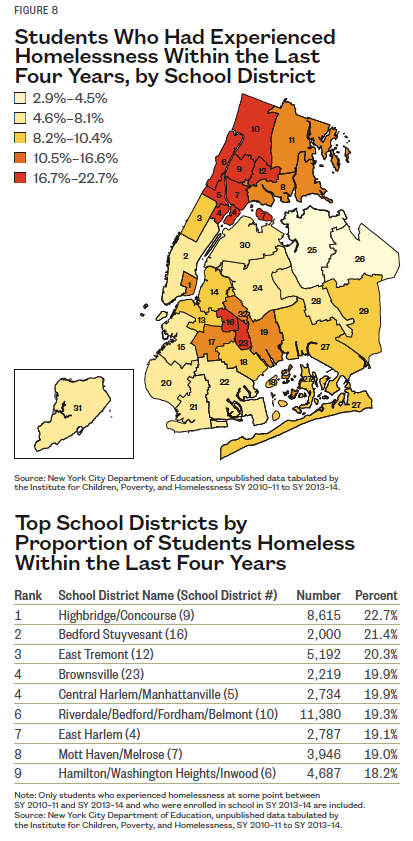February 2016
During the 2013–14 school year, over 117,000 public school students in New York City—11% of the total student population—were either homeless or had experienced homelessness within the previous three years. Educators have long known the negative effect that housing instability can have on a child’s education, but new evidence suggests that these effects do not end when a student is stably housed. Understanding the extent to which the instability created by homelessness can have a lasting impact on a child’s education is increasingly important for teachers, parents, and policymakers alike. This brief looks at the educational outcomes of homeless and formerly homeless students during the 2013–14 school year and the implications these outcomes have for education policy in New York City.
The number of homeless students in New York City Public Schools has risen by 64% since SY 2007–08 even as total enrollment remained constant. As seen in Figure 1, over 83,000 students attended school during the 2013–14 school year while living in some type of temporary housing, such as a family shelter or doubled up in another family’s residence due to loss of housing or economic hardship.
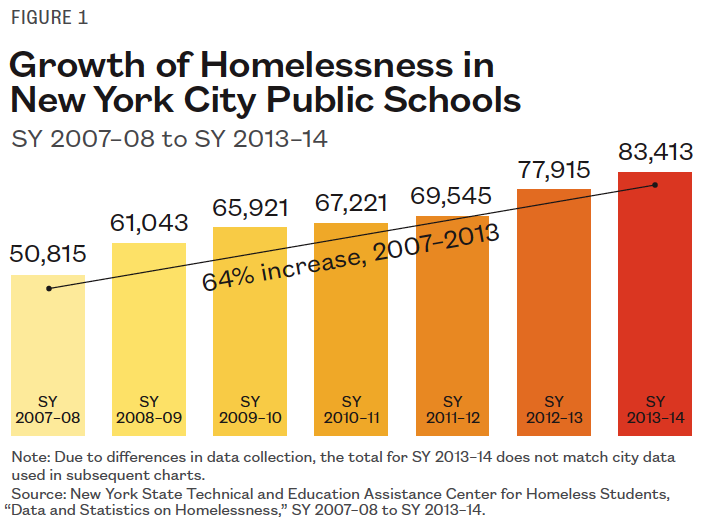
Key Findings
Homeless students achieve proficiency on New York State standardized English and math tests at roughly half the rate of housed students. In SY 2013–14 only 1 in 8 (13%) homeless students met grade standards in English and less than 1 in 5 (17%) did so in math.
The educational impacts of homelessness continue even after a student is stably housed. Students who experienced any episode of homelessness within the last three years score at the same lower proficiency rates as currently homeless students.
Formerly homeless students score well below low-income peers with no history of housing instability; poverty alone cannot explain the impact of homelessness on student achievement.
Recognizing homeless and formerly homeless students as a unique cohort may be the first step in designing solutions that meet their support needs and help them overcome educational deficits.
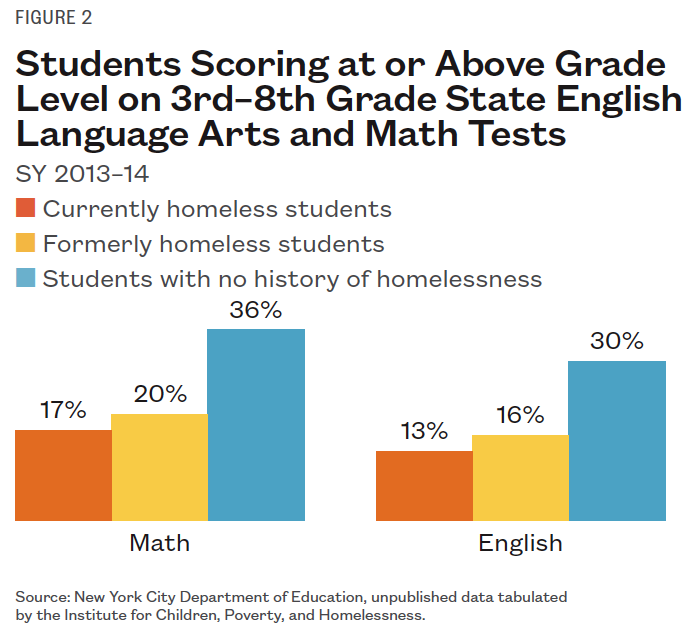
xxx
The Lingering Impact of Housing Instability and Homelessness
The effect of housing instability on student performance is most clearly seen once students begin taking State-mandated tests of math and English skills in the third grade. These tests receive significant media attention yet the impact of homelessness on student achievement is generally overlooked. In 2014, 36% of students with no history of homelessness performed at or above grade level in math. Currently homeless students performed far worse, with proficiency rates on both English and math tests close to 20 points lower than their housed classmates. In other words, just 17 percent of homeless students perform at grade level or above in math and only 13 percent perform at grade level or above in English.1
Importantly, as shown in Figure 2, the same lower performance held true for students that were currently housed but had experienced homelessness at any point within the previous three school years. Only 20% of these formerly homeless students performed at grade level or higher in math, only a 3 percentage-point improvement over currently homeless students. This same gap was seen on the test for English Language Arts, with only 16% of students with a past history of homelessness demonstrating proficiency.
1 The New York State grades 3rd–8th English Language Arts (ELA) and math tests are scored on a 1–4 scale. Level 1 students are performing well below proficient in standards for their grade level; Level 2 students are partially proficient; Level 3 students are proficient in standards for their grade level, indicating that they demonstrate knowledge, skills, and practices sufficient for expectations at this grade; and Level 4 students excel in standards for their grade. In this paper, both the terms “proficient” and “performing at or above grade level” encompass both Level 3 and Level 4 scores.
xxx
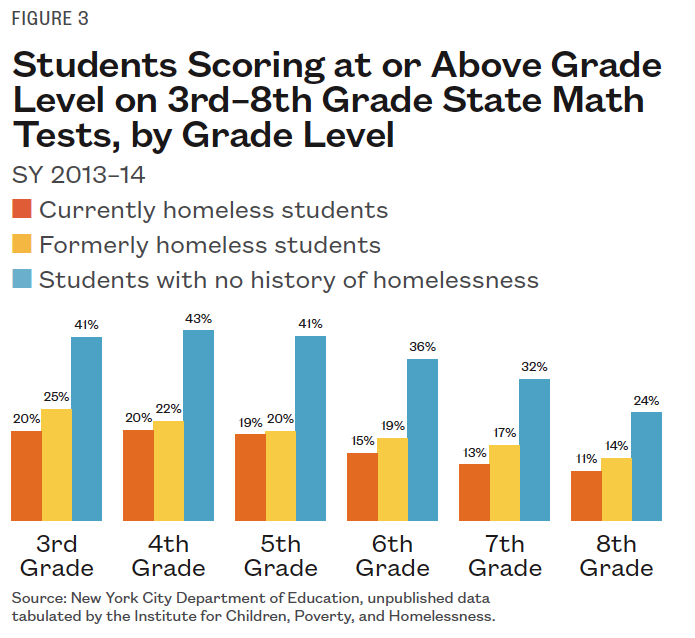
xxx
At all grade levels, the link between a student’s housing status and their performance on State exams persists. In the 3rd grade, 25% of formerly homeless students performed at grade level, compared to 20% of students that were homeless that year and 41% of those who had always been housed (Figure 3). Among older students, the small gap between formerly and currently homeless students remained consistent, with 14% of the formerly homeless scoring proficient or above and 11% of the currently homeless. Although the achievement gap with always-housed students shrinks between 3rd and 8th grade, this is the product of housed students performing worse. In all cases, proficiency rates for formerly homeless students were closer to those of their currently homeless peers than to those who had been always housed.
Poor performance in school is known to correlate with whether a student lives in poverty,2 but a family’s income cannot fully account for the effect of past homelessness on test scores. In New York State, students whose families earn less than 185% of the Federal Poverty Line are eligible for a free or reduced-price lunch. As seen in Figure 4, only 31% of housed students who qualified for the free lunch program scored proficient in math. This rate was still significantly higher than those students who were either currently or formerly homeless. Compared to the currently homeless, housed students not qualifying for a free or reduced-price lunch performed on grade level three times as often, and more than doubled the 19% proficiency rate for formerly homeless students who remained in poverty.
2 The Institute for Children, Poverty, and Homelessness, The Atlas of Student Homelessness in New York City, 2015.
xxx
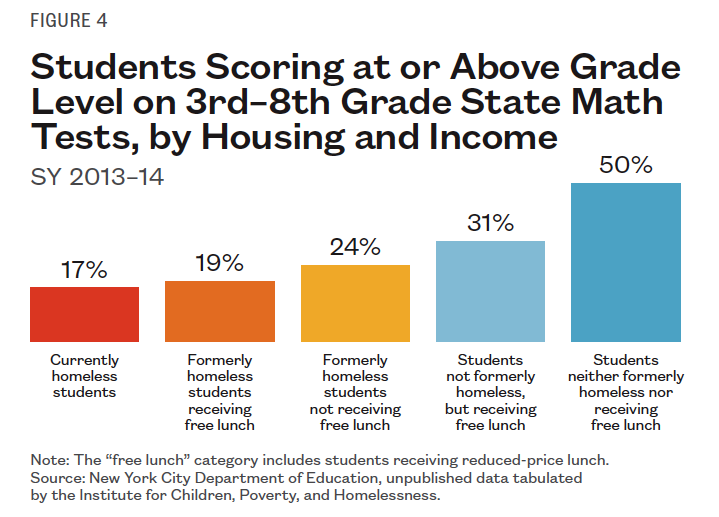
xxx
Evidence even points to the impact of past housing instability outlasting a family’s current economic status. Although they are a relatively small group, formerly homeless students that no longer qualified for free or reduced-price lunch still performed worse than low-income students who had never been homeless. Formerly homeless students also performed almost identically regardless if it had been one, two, or three years since they were homeless. By the same token, the number of school years that a student experienced homelessness did not have a noticeable effect.
xxx
Homeless Students are Disproportionately Young
There is no single explanation for the lingering impact of housing instability and homelessness on student achievement. We do know that many students first experience housing instability when they are very young, often years before they participate in standardized testing. Figure 6 and 7 show the number of homeless students in each grade level, with the largest single group in first grade (8,846 students) and over 29,000 in pre-Kindergarten through second grade, representing 36% of all homeless students. Among housed students, only 28% were in second grade or below. Students that are homeless at a young age risk not learning critical skills, as the earliest years of a child’s education are when students are taught basic reading and math that will be necessary in later grades. In addition, the trauma of homelessness can impede a child’s social and emotional development, with negative consequences long after that student is eligible for services.
Approximately 14,000 homeless students a year become stably housed the following school year, and in SY 2013–14 there were 6,000 formerly homeless elementary students whose homelessness had ended before they reached the third grade. The consistency with which the experience of homelessness, both past and present, corresponds with poor test outcomes makes it a potentially valuable screening tool to identify students most at risk for failure—particularly for young students who have not yet begun State testing.
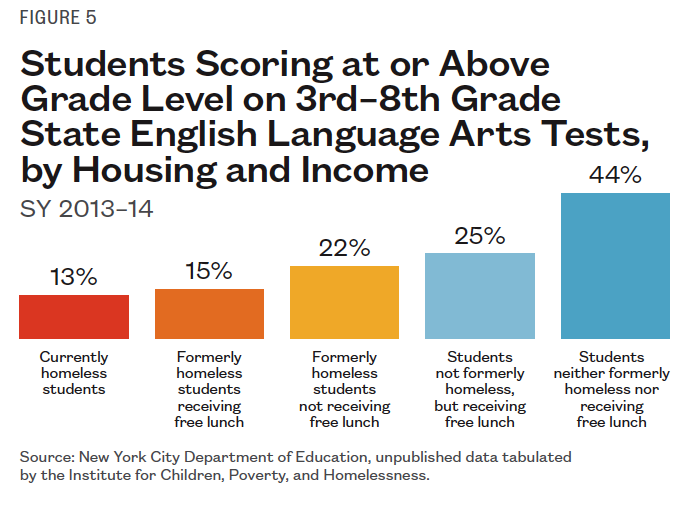
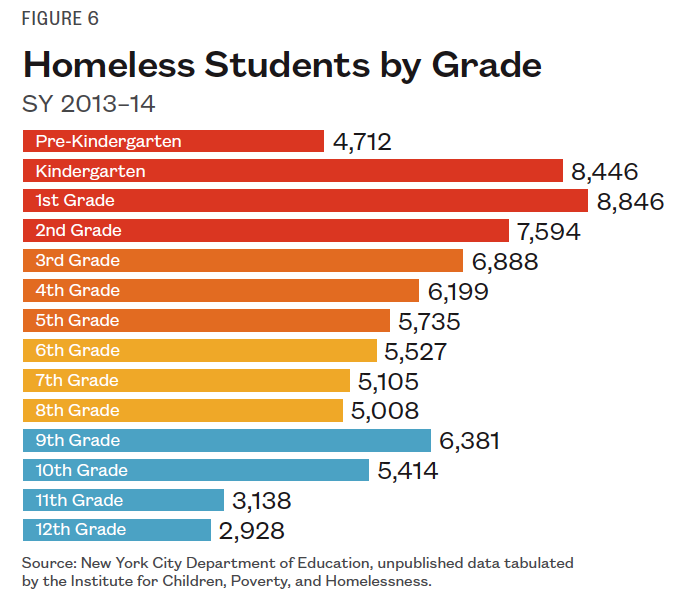
xxx
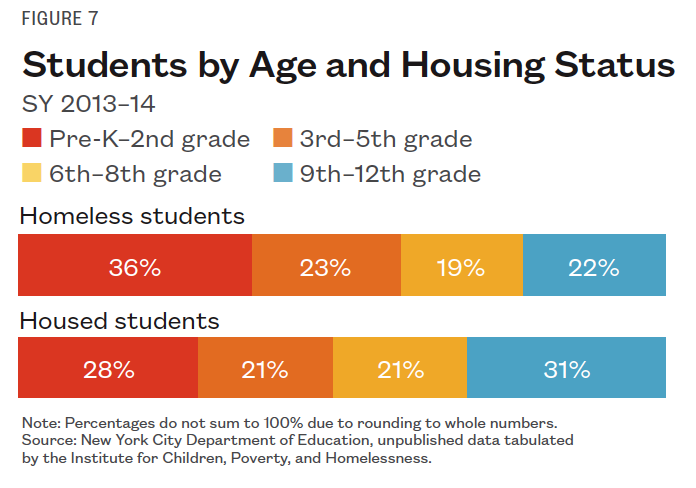
xxx
Addressing the Long-Term Effects of Homelessness
Improving student achievement for homeless and formerly homeless students is not as simple as addressing their housing needs. Understanding the prevalence of homelessness and housing instability experiences at the level of the school or even the classroom could be an important variable to consider when allocating resources to support the academic progress and improve subject matter proficiency for students who are struggling the most. The New York City Department of Education already collects information on the housing status of all students over the course of their enrollment in public school. With safeguarding student privacy as a guiding principle, utilizing this data to target resources represents an untapped opportunity to provide children and their parents with support and ultimately improve student outcomes.
With nine school districts where roughly one in five students experienced homelessness over the last four years and over 117,000 homeless or formerly homeless students in SY 2013–14, meeting the educational support needs of these students has never been more important (Figure 8). Student performance on State-mandated tests carry great significance not only for a student’s academic future, but for teachers and administrators as well. The persistence with which formerly homeless students continue to perform far below their classmates even after they are stably housed indicates how difficult it can be for students to catch up once they have fallen behind. Recognizing homeless and formerly homeless students as a unique cohort may be the first step in designing solutions that meet their support needs, help them overcome educational deficits, and succeed in later grades.
xxx
